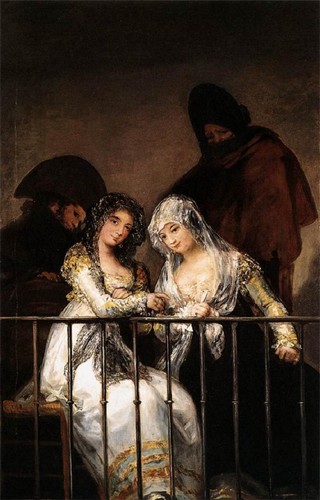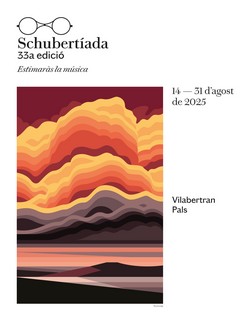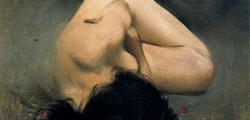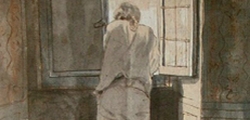
His corpus is articulated around two fundamental cycles, the Tonadillas and Amatorias which, as we will see, are very different in style and features. They are heterogenic cycles but both represent two milestones in terms of the extensive Lieder compositions in the first quarter of the 20th century; they open the way for works such as Falla’s Siete Canciones Populares Españolas (1914), the Vives’ Canciones Epigramaticas (1916), as well as later works.
The Tonadillas en estilo antiguo (Little tunes in old style), written between 1912 and 1913 on texts by Fernando Periquet Zuaznábar (1873-1946), were premiered on May 26, 1913 at the Madrid Atheneum, by the theatrical singer Lola Membrives with the composer himself at the piano. They were originally published in three parts progressively.
The inspiration for Tonadillas coincides with that of the suite Goyescas with its taste for the aesthetic of the 18th century, and of Granados admiration for the paintings of Goya. This music is not intended to be a copy of original themes of Spanish historical heritage, but more of an imaginative recollection, as the music he writes is before the appearance of systematic studies of music of this time, and his references were scarce to none. Granados creates his own musical universe: the songs contain a very schematic piano part, guitar resonances dominated by staccatos; naked of ornamentation with a simple and straightforward settings of text to vocal line.
The word tonadilla does not refer in this case to the 18th century Spanish musical form of the same name (brief dramatic pieces), but it comes to us in its diminutive form of "tune" or small song, reaching towards the popular style of “majos” and “majas” that refers to an epoch (and before the appearance of the romantic era zarzuela that incurred so many clichés), as well as the the "genuineness" that it presupposes. American musicologist W. A. Clark in his biography of Granados mentions a list of scenic works that treat characteristic of Goya's works topics, and the Tonadillas were used by Raquel Meller on the following year of his premiere for a theatrical function in Barcelona. There seems to be a running plot and dramatic thread that arches to the loving vicissitudes of a beauty, the compliments of her beloved, ending with a complicated personal relationships and lament for his tragic death; this is the story that we hope to represent in the recital that we are now preparing for the centennial celebration of the composer.
The cycle starts with an attractive recitative that tells a picaresque tale attributed to Goya. It is among the most inspired verses by Fernand Periquet, an author now somewhat forgotten. He is certainly more accomplished writing verse in the free recitation style of La maja de Goya, than fitting syllables to previously composed music (which was his task with unfortunate results in several of the wordy passages of the opera Goyescas).
When interpreting La maja de Goya, the singer and myself realized that the expression in the phrasing of the entire introduction should be subordinated in respect to the volume of the reciter and intelligibility of the text, as well as the dynamic range between the dynamics of piano and pianissimo; we made the choice of sacrificing the opulence of the piano sound to which we are accustomed in recordings by pianist Alicia de Larrocha.
What follows are the more vivacious pages of the cycle: "discreet" and "shy" majo, Callejeo (Strolling), Amor y odio (Love and hate), the Tralalá and the Currutacas modestas (The modest Currutacas), the latter being a delicious duet for soprano and mezzo-soprano that is rarely heard in its duo form, and where Granados shows his surprising facility to change from one key to the others with great refinement.
We now arrive at the "dark" songs such as El mirar de la maja (Maja’s gaze), with ostinatos full of pathos, and the song for baritone El majo olvidado (The forgotten majo), with its unstable and dark lines. Finally, the famous Majas dolorosas (The grieving maja), which are three painful and torn visions of loss, with tense intervals and harmonies that follow the text faithfully. The first song features a prominent part for an English horn. Though it duplicates an already present line in the piano, the horn obligatto leaves its mark on this composition with its sound of lament and pain.
The second section of the recital features songs for baritone and songs in the Catalan language, and which we will go over presently.
Cantar “Día y noche Diego ronda” (Song "Day and night Diego hangs about") is dedicated to the baritone Emilio de Gogorza, as the already mentioned "Forgotten majo", and it was never published during the life of the composer. There is a transcription of this piece for violoncello, entitled Madrigal, by which the piece acquired later diffusion. A recent complete edition of songs by Granados, edited by Morante-Tritó and Riva-Boileau, have recovered the original versions for voice of the score. According to pianist Douglas Riva, this piece originally intended to be included in the Amatorias and it was annotated in that same manuscript; it is therefore possible to date this song to around 1914.
It sounds much like troubadour tune, nostalgic and almost elegiac; a simple modal harmony accomplishes this. The rhythm flows profusely, precious with its grace notes and thirty-second notes, triplets and quintuplets, all suggesting the use of rubato. The interventions of the piano mark the different interventions of the soloist. The male voice enters with great calm and with a declamatory, slow style. The text is anonymous, and speaks of the beauty of a young woman who fascinates all the men of the village. A brief B section, accompanied by a few legato and harp-like arpeggios leads back to an exact reprise of the first part to happy closing on an A major chord.
La Boira was premiered on February 13th, 1902, in the Chaissagne Hall (Barcelona. It is undoubtedly one of the most ambitious pages by Granados; enough to confirm this is the extensive piano introduction that begins the work. The music advances slowly and in solemn way, with organ-like writing, reinforcing the low octaves and resembling Central European composers atmosphere. The voice enters inadvertently, and quickly rises up with whole notes up to a G, which is repeated several times during the course of the song. The musical image shows us clearly an old hermit high upon a rock.
The writing of the piano becomes smooth with sinuous harmonies, until we enter the B section, in which appears the element that gives its name to the song: the fog (a very common phenomenon in the town of Lleida, birthplace of the composer). In subtle descending arpeggios, the piano draws a transparent and crystalline atmosphere of impressionistic inspiration. The fog takes a woman's form. After a dark transition that reflects the interior fight of the hermit who starts to pray, the song returns to the calm and light of the sun with the initial theme, closing the piece in an elegant and serene way.
The text is by Apeles Mestres (Noves balades, 1893), who was a close collaborator of the composer in several of operatic works of Catalonian setting. The language resembles that of his opera librettos, full of images of idealized nature and touches of medievalisms, in the line of the Renaixença, (the Catalan cultural Renaissance movement of the early 20th century), with which both authors felt strongly linked.
Mestres is the author of another of Granados most inspired songs in the Catalan language: Elegia eterna (Eternal elegy) dedicated to the soprano Maria Barrientos, who performed it in London on June 20, 1914. Again, here is an archaic atmosphere reinforced by a declamatory style, in which the piano accompanies in false improvisation, ending in a forceful last section, with the voice eschewing text and flying poetically in an high voiced vocalise.
The Canciones Amatorias (Love songs) were premiered at the Granados Academy of Barcelona on April 5, 1915; the first interpreter was soprano Conchita Badia, (two of the pieces from this cycle are dedicated to her). According to important information that Morante contributes, there remains a copy (dated 1851) from the Spanish Romancero, the text collection from which the composer extracted the texts: specifically, penned as being excerpted from seven of the Erotic and Love Romances: four of them are anonymous, two are by Luis de Góngora and one of Lope de Vega. They all correspond to the final part of the poem (“cantar” / song).
Mira que soy niña (Look, I’m a little girl), plays with two confrontations: a rhythmic one, mixing measures of ternary subdivision with binary; and tonally: with sudden changes between flat keys (G minor, E flat major) and diatonic (E minor). Llorad corazón (Weep, my heart), is the simplest piece of the cycle: a tripartite song in the romantic style. No lloréis ojuelos (Do not cry, little eyes), is fast and passionate blast, constructed on the dense arpeggios of irregular measures and the constant raises of the voice to the high region. Descúbrase el pensamiento (Reveal the thought), is the most cryptic of the cycle, with a considerable duration and difficulty, and with several sections that include complex final tunings for voice solo. Iban al pinar (Girls went to the pinewood), is a rhythmic, popular song although wrought with elaborate harmonies. Mañanica era (It was early morning), is illuminated with a limpid and crystalline color; it only gets dark at the end with a change to A minor, and here, the song gives the feeling of a "quejío" (lament). The final song Gracia mía (My dear grace), is an exaltation which arises fiercely with the impetuous rhythms of the piano.
Our journey with this recital began at the Hispanic Society of America in New York City, and recalls the glorious but last and fateful voyage of the composer to New York a century ago. The First World War prevented the premiere of the operatic version of Goyescas in Europe, but the work had its world premiere at New York's Metropolitan Opera House. Taking advantage of his stay, Granados had productive musical activity during those months: he recorded piano roll cylinders at Duo Art Recording, and appeared in numerous concerts together with cellist Pau Casals. The rehearsals of the opera were full of vicissitudes; among them the duration of the instrumental had turned out to be insufficient length for the change of the scenery, and the theater management asked the composer if he could write a longer piece. Thus was born the famous Intermezzo, sketched in only one night but a masterpiece of refinement and masterful in its outline.
The composer had also proposed a dance piece for Goyescas for his friend the Spanish dancer Antonia Mercé "la Argentina" but again, the intrigues of the theater did not allow her to be part of the opera premiere. To compensate the broken engagement, Granados dedicated to the dancer La Danza de los ojos verdes (Dance of the green eyes), which is inspired by her expressive and seductive eyes; with this work, the dancer appeared at the Maxime Elliot Theatre in New York on February 10th, 1916, costumed by the Spanish painter Ignacio Zuloaga and with Granados himself in the audience.
Soon, the plans of return to Spain were modified by an invitation to the White House, which put into place the fateful end that we all know, when the composer prefers the mail boat Sussex to a Spanish ship, and therefore neutral in the war conflict. We can affirm that Intermezzo and Danza de los ojos verdes constitute the last works by Granados during his New York trip, which had filled him with enthusiasm for new projects, and which, unfortunately were never realized. As was the case of Isaac Albéniz, these two composers were truncated in their creative evolution and at their culminating peak. The visit by Enrique Granados to the city of New York has left its mark in the room where this same recital was heard for the first time in December of 2015. Among the paintings by Goya, and nearby in the library of the Hispanic Society of America is the manuscript of the opera Goyescas, a witness of this illustrious gentleman from Lleida: his signature is on one of the columns of the Society for the posterity.
Al mig del desert, al cim d'una roca,
resseques les carns i extintes les forces,
un vell ermità saluda l'aurora!
Del fons del barranc s'aixeca la boira,
s'aixeca suament i escala la roca
com serp ondulant, com serp tentadora.
Manyaga va i ve, s'allarga i enrosca,
manyaga flotant pren tintes de rosa,
pren tintes de carn i formes de dona.
I a sota sos peus la veu el sant home,
li sembla sentir un bras que l'estreny
i el cor li avalota.
El vell clou els ulls i prega amb més força,
i es colpeja el pit i el Senyor implora.
Però esclata el sol i desfà la boira.
Alone the midst of the desert, on top of a rock,
with scorched flesh and exhausted,
an old hermit greets the dawn.
From the depths of the ravine,
the fog rises and climbs the rock
like a writhing snake, like a tempting snake.
Its caress comes and goes, it twists and turns,
the floating caress takes on shades of pink,
it takes on shades of flesh and form of a woman.
And beneath his feet the holy man sees it,
he thinks he can feel an arm pulling
him and agitating his heart.
The old man closes his eyes and prays even harder,
hitting his breast and imploring God.
But he sun breaks through and lifts the fog.














Comments powered by CComment